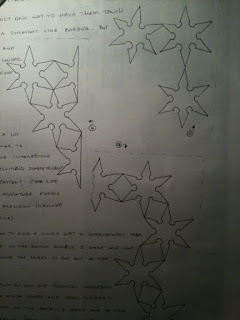The counter-change [A-i] was fun and interesting to do and satisfied my value of being precise with cutting ;-) First, I found a ninja star shape and added a small 6-pointed star in the center for interest. Next, one of the shapes of the star trek badges. The picture I found had a light shining from behind, which made it look like a 5-pointed star. I wonder if that's how the designers came up with the original design back in the 60s. I'm sure the more recent badges were based on a distortion of a star because the small inner star has simply been stretched upwards.
I'd wanted to do something with the 8-pointed star, so I chose that for the interchange sample [A-ii]. I like the contrasting shades and was surprised at the new inner shape - a cross!
For the a/symmetry and distortion sample [A-iii, A-iv, and A-v], I chose another 8-pointed star. I have a very simple computer program (ImageTricks for Mac) that will do various things to an image. I played around with it and compiled some samples (see earlier blog entry). I used that to stretch the star into different distorted shapes and then cut them out.
The distortion into diamond, circle, triangle, and square [A-vi] was more thought-provoking because I wasn't able to do this on the computer... I had to imagine how the star would distort within the shape. I used a compass to round out the points within the circle and the diamond (not sure that's accurate, but...) and stretched the star into the triangle - sort of opposite the widened star trek symbol. I wasn't really happy with squaring off the points of the star in the square - it just looks like it's been enlarged. How else could I have done that?
[A-vi-a] alternative distorted stars
(Total time on Design Sheet A = 13 hrs 40 mins)
* - * - * - * - * - * - * - * - * - * - * - * - * - * - *
Design Sheet B
[B-i] I began this section with a simple 7-pointed star, but didn't find it very challenging. Switched back to the ninja star shape. Interesting negative shapes in B-ii (like a UFO?). [B-iii] Had a problem with the border and corner pattern repeat because this star shape is closer to a circle than a square, so creating a 90-degree corner was a bit of a challenge... I saw only one way to have them touch together and still make a straight line border. But when I came to the corner and changed directions, they no longer touched together in a straight line but rather created either a zig-zag or a half-star line [see B-iii-a below].
image B-iii-a
[B-iv] The linking border was a lot of fun. I chose a 6-point star to interweave and found some interesting patterns - sometimes intertwining symmetrically and sometimes not. Very patient, detailed work. Almost like making miniature models of something. I like the precision involved (though I need more practice).
[B-v] In the top sample, I tried to find a simple way to interconnect them without cutting either shape. In the bottom sample, I made one cut in the ninja star and interwove the spokes in and out of the 6-point star.
[B-vi] Creating a new shape from an old one produced interesting patterns when I used the ninja shape and then turned it 30 degrees when tracing that shape on the back. I made one of each of these in each color scheme (reddish-orange / blue-turquoise), and found that the negative patterns were just as interesting as the positive ones. Then I tried again but using the 6-point star as the cutting pattern on the back of the original square. I like the results of this most of all. It seems as though there is more contrast of shapes because the eye is drawn not only to the star in the center, but also to the star shape that isn't there (the negative of the 6-point star).
(Total time on Design Sheet B = 12 hrs 30 mins)
* - * - * - * - * - * - * - * - * - * - * - * - * - * - *
Design Sheet C
I had wanted to do something with the 8-pointed star in Design Sheet A, so it appears here in the "sub-divided and counter-change" [C-i].
I then took two different sections to work with (new motifs A and B), as well as a leftover shape (new motif C).
With new motif C I tried many different patterns and arrangements but liked these most. They are quite simple, and they remind me of some Native American art, C-C4 and C-C5 in particular.
If I do this again (if I had done it differently), I would use larger pieces, differently-colored paper, and something other than newsprint for the background.
Still, I am relatively pleased with parts of the outcome (C-A2, C-B3, C-C4). I did not mix the three new motifs. I tried a few combinations, but they didn't produce patterns I like. They looked more like pieces that had just been thrown down haphazardly, and although that would be one option, it doesn't fit my need for tidiness ;-)
(Total time on Design Sheet C = approx 9 hrs)
* - * - * - * - * - * - * - * - * - * - * - * - * - * - *








